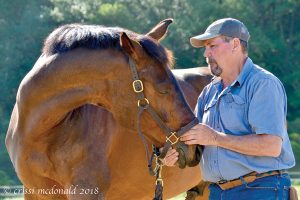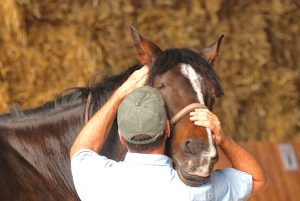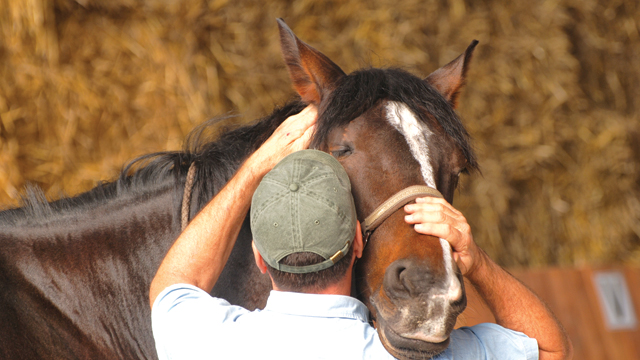This article appeared in issue No.136 of Eclectic Horseman Magazine – Order a print copy or order a PDF copy.
Paradigm shift: noun
A fundamental change in approach or underlying assumptionsA paradigm shift in horsemanship began in the American West in the mid-Twentieth century when Bill and Tom Dorrance began showing an effective, gentle way of horse training that emphasized feel and observations of horse behavior over the use of domination. Ray Hunt, Buck Brannaman, and Pat Parelli are notable figures who pushed that message out into the world, teaching humans and their relieved equines what became known as “natural horsemanship.”
Today, who are the teachers continuing this arc of what we can call “horse-humanship”? Who are the thinkers encouraging us to see and train and relate to horses from a grounded, scientific, and more humble platform of curiosity and wisdom?
This Eclectic Horseman series interviews just a few of the notable people—from trainers to body workers to veterinarians—who are putting the pieces together a little differently, and teaching us how to be better for our equines.
The penny dropped with a blink for Jim Masterson.
In 1998, working as a groom for a hunter-jumper show barn, he watched equine chiropractors, acupuncturists, and massage therapists who got good results, but at the time Masterson was more absorbed by horse behavior than compelled to become an equine bodyworker.
“I was more interested in observing horses, and working with them, than in therapy,” he says.
But a couple of equine massage therapists introduced him to something called the “bladder meridian.” Central to Chinese traditional medicine and acupuncture, which dates back to 2,600 BCE, meridians are considered to be the circulatory systems of energy in the body, much like the blood circulatory system. These massage therapists simply ran their hands along the line of the bladder meridian to relax the horse prior to massage, but Masterson saw something more from the equines.
 “When I first tried it myself I noticed the horse would blink, so I stopped and just waited with my hand on the spot where he blinked just to see what would happen. I remember this horse dropped his head and started licking and chewing and then started yawning repeatedly, and I thought, ‘Wow. This is a pretty huge sign of a release of tension.’ That’s when I put two and two together.”
“When I first tried it myself I noticed the horse would blink, so I stopped and just waited with my hand on the spot where he blinked just to see what would happen. I remember this horse dropped his head and started licking and chewing and then started yawning repeatedly, and I thought, ‘Wow. This is a pretty huge sign of a release of tension.’ That’s when I put two and two together.”
Two and two eventually led to a modality of equine bodywork called the Masterson Method: an interactive method of bodywork in which the human observes and uses subtle changes in equine body language to get not-so-subtle results that show the horse has released body tension.
“I started doing it more and more as I was grooming,” says Masterson, “and then I started adding stuff in, like wiggling the nose and working down the neck (when the horse was) in a relaxed state. Every time the horse would brace I would yield and soften myself and wait, and then the horse would release. I didn’t use force, I softened, and I realized the horse would release tension on its own.”
By applying light levels of touch and adding some relaxed movement to the horse’s body in a way that the horse’s nervous system was unable to guard against, Masterson found the horses showed him specifically where they were holding tension. When he waited without pressure, the horse’s nervous system released the tension, and the horse’s responses—licking and chewing, yawning, sneezing, scratching, lying down—told him the equines were letting go of stress in their bodies.
Dr. Steve Peters is a neuroscientist who specializes in brain function in both humans and equines. A passionate horseman, Dr. Peters often runs clinics with Masterson and is very familiar with how the Masterson Method works and why it is effective.
“The big key with the Masterson Method is that it allows the horse to have an internal locus of control, rather than having something done externally to them,” Peters says.
“You touch the horse, move your hand above the horse, and you stop. At that moment the horse is producing oxytocin, a bonding chemical, so you can actually lay hands on them. They are producing serotonin, giving them emotional balance. Then the neurochemical cocktail switches a bit and norepinephrine is produced, which sensitizes everything. If you pressed the horse at this point, they would up-regulate. The horse has some control over this, and that is key because at that point in time they can start to let down because they are not getting pushed. What I’ve seen Jim do is at that moment he backs off and lets the whole neurochemical process change such that the horse goes from having a state of slight arousal to having a dopamine release. If he kept pressing or pushing, he would get in the way of what the brain needs to do.”
Dr. Peters continues: “I’m a big fan of Jim and his work.”
Masterson says he slowly put the pieces together of how and why his modality of bodywork was effective.
“I’m not a huge researcher, but I would do a little bit of reading and I would talk to people and then realize –oh, that’s probably the sympathetic and parasympathetic systems acting. The (Masterson Method) techniques and movements evolved from just going and testing for movement of a joint or junction in a relaxed state, which helped me find the tension because the horse will brace when it feels tension. And when you soften, it’ll eventually release. So it was just kind of a progression of those things that that led to the techniques that work.”
Pretty soon word got around about the groom-turned-equine-massage-therapist who got great results, and Masterson found himself working for the 2006, 2008, 2010, and 2012 USET Endurance Teams, as well as helping equine clientele that were competing in FEI World, Pan American, Nations Cup, and World Equestrian Games competitions.
And horse folk started asking him to show them how to do what he did.
“Pretty early on I realized, one: these methods worked, and two: people wanted to learn. Not necessarily horse trainers. But when I started working on people’s horses outside the show world, they were attracted to the interaction with the horse. They could do the work and see their horse relax, release tension, and then they could feel and see the difference in the horse. People wanted to learn how to do that work and have that connection with their horses—and it was teachable.”
Masterson was a kid who loved animals from the get-go. He has stories of living in the Congo and playing with baboons when he was a teenager:
 “Baboons are interesting because their body language is really clear. I was fascinated by their behavior. They have these white, bright-blue eyelids and when they show their eyelids or teeth it’s a sign of aggression or fear, which is a sympathetic state, right? I would show my eyelids like that and they would they would show me their eyelids and grab my shirt and start shaking it, and then then I would go back to smacking my lips to settle them back down. It was a little game. So that probably had something to do with the observational part.”
“Baboons are interesting because their body language is really clear. I was fascinated by their behavior. They have these white, bright-blue eyelids and when they show their eyelids or teeth it’s a sign of aggression or fear, which is a sympathetic state, right? I would show my eyelids like that and they would they would show me their eyelids and grab my shirt and start shaking it, and then then I would go back to smacking my lips to settle them back down. It was a little game. So that probably had something to do with the observational part.”
But horses were always a huge draw. Masterson spent summers as a kid on a cattle ranch in Southern California, and he had a horse he had a relationship with. Kids typically interact with horses without fear or expectation. They have the gift of being, rather than judging.
“As an adult I always wanted to get back to that connection with horses,” Masterson says.
The adult desire for connection, for a kid’s ability to be rather than get all thinky, was deepened by his practice of Transcendental Meditation (TM), which aided his ability to understand and develop the techniques that would become the Masterson Method.
“What you learn in TM is to just settle down, quiet your mind a little bit, and wait. When I started working with horses I was able to wait for the response. And it’s easier to wait when you’ve already experienced how to wait.”
The Masterson Method is remarkable in that a person does not need a special degree or long years of training to effectively help a horse release tension and feel better in its body. The coursework to learn the basic Masterson Techniques begins with a two-day seminar, and builds from there, allowing both backyard horse owners and professional equine bodyworkers to follow their inclinations as to the level of training they want to receive. Currently, over 500 people in 27 countries worldwide have become Masterson Method Certified Practitioners, and countless more have taken seminars to simply help their own horses.
 But Jim Masterson’s horse-humanship goal goes beyond just how many people in the world will learn multiple Masterson Method Techniques. He wants the horses get help to heal themselves. All of the horses.
But Jim Masterson’s horse-humanship goal goes beyond just how many people in the world will learn multiple Masterson Method Techniques. He wants the horses get help to heal themselves. All of the horses.
“My personal goal is that every horse on the planet will have experienced the Masterson Bladder Meridian at least once in its life.”
To that end, Masterson gives instruction on how to do the Masterson Bladder Meridian Technique away for free to anyone who is interested. This simple, powerful practice can be done by anyone of any age or ability who has the willingness to observe horses with patience and humility, to soften themself, and to wait on the horse.
Helping people help horses—and helping us see the subtle and nuanced ways horses communicate with us—is why Jim Masterson is someone who has pushed the paradigm of horse-human relations in a positive direction.
Three Questions
What is a horse?
“Kind of a lot of things. Let me think… They are survival-oriented. So super-sensitive. They are pliable—they take the path of least resistance and will follow and learn and release tension. They are not analytical but are very clear about what’s in front of them. Put all that into four legs and a huge amount of muscle and you have a horse.”
Who are you?
“I’m sentient, observational. I want harmony and want people to be comfortable, happy. I’m stubborn, a bit of a perfectionist. A super-achiever, and pretty security-minded.”
What are some things you hope people take away from reading an interview with you?
“My biggest takeaway about bodywork or anything you do with horses is that they pick up things that are so subtle, and we just miss it because we’re aiming for a target. If you just slow down, pay attention, and wait—whether it’s in training or releasing tension (in bodywork) or whatever—if you just wait for the horse to get it, then they will get it. If it’s physical, they’ll let it go physically; if it’s mental and they’re learning something, then they get it and let it go physically. We miss so much they’re telling us by not waiting for them. That’s probably the biggest takeaway.”
FOR MORE INFORMATION
Learn the Masterson Bladder Meridian Technique
The Masterson Method Bladder Meridian Technique
[ux_custom_products cat=”magazine-subscriptions” products=”” columns=”4″ title=”Want to know who the other Paradigm Shifters Are?? Subscribe Today!”]


